The early motor races were contested over the ruler-straight Routes Nationale of France, and for a good reason. Firstly, the French received the emergence of the horseless-carriage as a practical means of transport with more understanding and far fewer restrictions than those it was plagued with elsewhere, particularly in England. Secondly, the pioneers were faced with the task of making carriages drawn by mechanical means (instead of behind horses or other suitable animals) prove that they could, in fact, represent an effective replacement. For this reason their primary concerns were making the new vehicles run with a modicum of reliability and safety and then to show that these auto cars, automobiles, motor cars, as they were variously called, were able to cover a reasonable amount of ground and at far higher speeds than animal-propelled carts and carriages were capable of doing.
Thus, the best means of both proving these matters to a sceptical public and of improving the design and construction of the motor car itself, was accomplished by organising races, which were thus generally well supported by those who saw a big commercial future for the motor car and by those who, liking these new exhilaratingly fast vehicles from the sporting viewpoint, realised how essential it was for them to prove themselves, so that authority would not frown on them. Because these rapidly grew larger, more powerful, and therefore faster, they made it plain that the horse had met its match and that even express trains might soon be unable to match the performance of these new petrol-burning motor vehicles.
The Paris-Bordeaux-Paris
The first proper motor race, contested in 1895, was the Paris-Bordeaux-Paris race, but the Paris-Madrid race of 1903 which was stopped at Bordeaux by order of an irate Government because of the many accidents which occured, mandating that all future contests be held over until properly policed closed roads could be organised. But these were still public roads fenced off and guarded for the purpose, usually triangular circuits of considerable length. This continued to be the norm up to and even after World War 1. The result was that cars were raced, and thus demonstrated, under normal road-going conditions, having to contend with hills, conventional corners, cambered road surfaces, dust and other natural hazards of the kind encountered by travellers.
As time moved on, it became logical to institute classes for the various-sized vehicles that were entered for these exciting contests of speed and endurance, and eventually to impose certain restrictions on the engineering factors of the motor cars that were soon being specially constructed for racing purposes. From primitive things that were decidedly experimental and, in fact, mere horseless-carriages, they quickly became fast, then very fast, decently reliable and controllable by the standards of their time. For this reason, those long-ago, courageously fought motor races of the pre-1915 period were exciting to watch, and important to analyse after they had been run off.
The Paris-Rouen Trials
The cars that contested them, from the earliest Panhard & Levassor to the 4
½-liter overhead-camshaft Mercedes which put up an all-conquering 1-2-3 victory in the 1914 French Grand Prix (to the consternation of the French on the eve of war), are historically interesting, and the handful that survived and have since been restored to running order are beautiful machines to own and drive. Before the first full-scale motor race was run in 1895 there had been the important Paris-Rouen Trials of 1894. The best performance in these was made by a De Dion steamer which was able to carry six persons. This was really a steam tractor and, although it headed the finishers, which comprised thirteen petrol cars and seven more steam vehicles, it was not given a prize.
The important cars at the time were the Peugeots, which had Panhard & Levassor engines which were hung at the back of a low chassis frame made of hollow steel tubing, through which the cooling water circulated. Final drive was by side chains but the whole conception of the carriage was crude, to later eyes, with wheels of different sizes front and back, although some did have wire-type spokes, and steering by a lever atop a vertical column, as was then customary. The 1894 Panhard & Levassor cars had already set the fashion others were ultimately to follow, in mounting their engines at the front of the frame. The engine itself in these cars was a V-type Daimler motor, the larger of the two sizes used being of 75mm bore x 140 mm stroke.
This power unit, which had its two cylinders angled at fifteen degrees from the vertical, developed about 3
½ hp at 750 rpm. Ignition was by the prevailing hot-tube, obviating electrics, and a surface carburetor was used, although the Panhard engineers already had a float-feed carburetor on the stocks, which was fitted to one of their Paris-Rouen entries. The drive from the V-twin engine went through a double-cone clutch to a gear chest which gave three, or in some models four, forward speeds, it being notable that these gears were not always enclosed in any form of casing. Reverse was obtained by keying one of two gears to an intermediate shaft, from which the final stages of the transmission consisted of single-or double chains.
The short-wheelbase, high-perched Panhard was controlled by a left-hand steering lever that was said to transmit jolts from every stone or rut encountered by the front wheels. The driver had quite a handful to contend with, as the throttle and governor controls were before him and with his right hand he worked the levers for changing gear, reversing and applying the side brakes. There were also the usual pedals, and foot and hand brakes were interconnected with the clutch. Radius rods tensioned the driving chains. Thus, the first-ever competition cars! They had low-power governed engines with unpredictable carburation, and ignition at the whim of the wind, which could snuff out the burners on which the platinum hot-tubes relied. They were terrible to steer, and gear-shifting was a difficult accomplishment. But at least they pointed the way to better, and certainly far faster cars to come, and were just about practical, which cannot be said of those Paris-Rouen entries which proclaimed motive power achieved by gravity, hydraulics, compressed-air, multiple levers, pendulums or just the weight of the passengers.
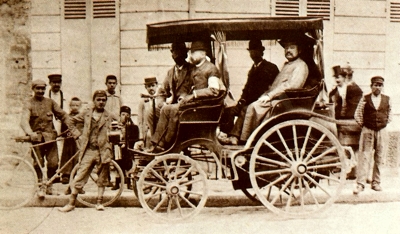 A Panhard 'Noveau' competing in the Paris-Rouen Trial of 22nd July 1894, driven by Monsieur Dubois. The first prize was shared by Panhard and Peugeot, but the car pictured could only manage 10th place.
A Panhard 'Noveau' competing in the Paris-Rouen Trial of 22nd July 1894, driven by Monsieur Dubois. The first prize was shared by Panhard and Peugeot, but the car pictured could only manage 10th place.
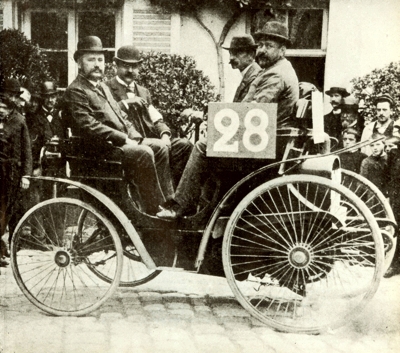 A Peugeot Vis-a-Vis which passed the finishing line first in the Paris-Rouen Reliability Trial and shared the prize money with the second-placed Panhard; the car was driven by a Monsieur Doriot, who is seen in this photo seated next to Pierre Giffard, the organiser of the Trial.
A Peugeot Vis-a-Vis which passed the finishing line first in the Paris-Rouen Reliability Trial and shared the prize money with the second-placed Panhard; the car was driven by a Monsieur Doriot, who is seen in this photo seated next to Pierre Giffard, the organiser of the Trial.
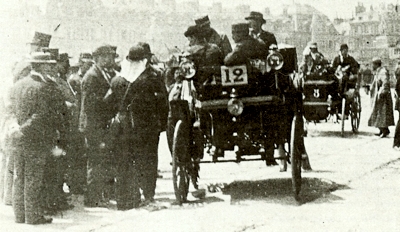 An early photo taken during the 1894 Paris-Rouen. In the foreground (Number #12) is a Roger, and behind that (Number #3) is a Panhard and Levassor.
An early photo taken during the 1894 Paris-Rouen. In the foreground (Number #12) is a Roger, and behind that (Number #3) is a Panhard and Levassor.
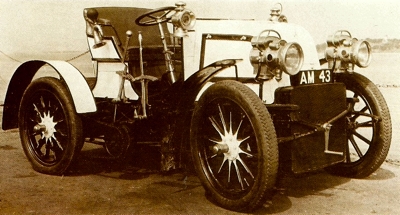 1899 Cannstatt-Daimler 'Phoenix' racer. These cars exhibited many advanced design features, including a honeycomb radiator and gate gearchange.
1899 Cannstatt-Daimler 'Phoenix' racer. These cars exhibited many advanced design features, including a honeycomb radiator and gate gearchange.
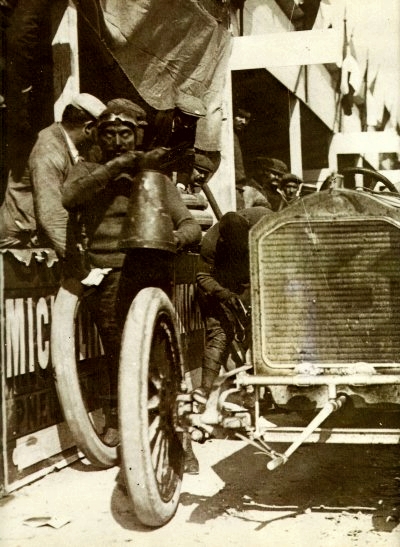 A pit-stop during the 1908 Coppa Florio with Trucco's Lorraine-Deitrich taking on fuel. Trucco went on to finish second in the race.
A pit-stop during the 1908 Coppa Florio with Trucco's Lorraine-Deitrich taking on fuel. Trucco went on to finish second in the race.
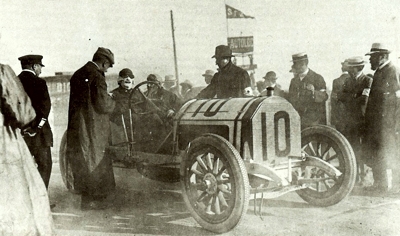 1908 Austin 100hp Grand Prix car, which was loosely based on a road-going production car. The Austin pictured was powered by a 9677cc straight-six engine, but unfortunately the car was far too heavy to make it competitive.
1908 Austin 100hp Grand Prix car, which was loosely based on a road-going production car. The Austin pictured was powered by a 9677cc straight-six engine, but unfortunately the car was far too heavy to make it competitive.
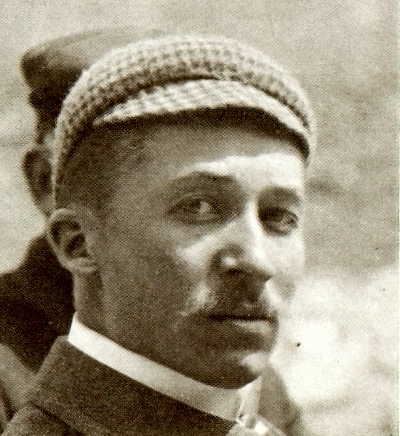 Jules Goux, a Peugeot Works Driver.
Jules Goux, a Peugeot Works Driver.
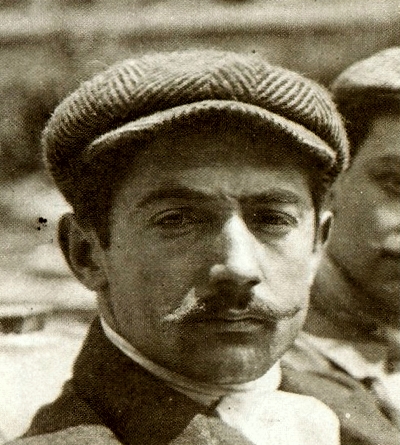 Georges Boillot, another Peugeot Works Driver who, togther with Jules Goux, were renowned for the driving talent and their engineering ability. This photo dates from 1908.
Georges Boillot, another Peugeot Works Driver who, togther with Jules Goux, were renowned for the driving talent and their engineering ability. This photo dates from 1908. |
The 'Phonix' Engine
Most successful of the 1894 primitives, the Peugeot, covered the 781-mile course at an average speed of 11
½ mph. By the year 1895, when the first real motor race took place between Paris and Bordeaux, Panhard & Levassor had progressed further. They had their own engine, which they called the 'Phonix', a vertical twin-cylinder power unit. Still a very crude, short-wheelbase machine, nevertheless, the advent of the ever-more powerful engine must be recognised. This successful 1895 Panhard & Levassor had solid rubber tyres and retained hot-tube ignition, although as it had its engine at the front the burner was less affected by the wind than those of the Peugeots, with their low-hung rear-placed engines close to the draught and the dust.
The Panhard's steering gear was still direct-acting and reversible, thus calling for great strength and continual concentration. The winning Panhard & Levassor weighed 604 kgm; and its engine developed some 4 hp at 500 rpm, from cylinders of 80 x 120mm, which was sufficient to give it a maximum speed of 18
½ mph. The gears were now enclosed to protect them against dust and road grit. It is interesting that at this stage of automobile development, although the pneumatic tire for racing had made its appearance, it was very unreliable and it was the solid rubber tire , as used on the 1895 winning Panhard & Levassor, which ruled supreme, superior to the iron tyres which were employed on some of the competing vehicles.
Ever-more-lusty power units were the hallmark of these early motor races. The four-cylinder 8hp Panhard & Levassor engine had appeared in that 1895 Paris-Bordeaux event and when this type of race was repeated the following year it was just such a car that proved victorious, averaging 14mph over 1062 miles of decidedly indifferent roads, for the race was not only out of Paris to Marseilles but the competitors had to return to Paris. So, we find the monster racing car already in evidence as early as 1896, because in those days of insipid little cars of 3
½ to 4 hp, an eight-horsepower Panhard was indeed a monster. Yet, exciting as such giant racers seemed to the public of the late 19th century, it must be remembered that they relied on crude brakes, a spoon on the back tyres supplemented by a contracting band on a drum on the transmission; that after dark they had to rely on candle-lamps for illumination of the tree-lined unlit roads they raced over, and that suction-opened automatic inlet valves were as commonplace as the solid tyres, tiller-steering and tube-ignition.
Yet, it was these great town-to-town contests that were forcing the pace of design and evolution, both of racing cars and ordinary automobiles and were also making the name of
Panhard & Levassor famous and France the premier country among the car-building nations. From that time onwards, it was a case of increasing the size of engines to force more speed from these wooden-framed, cart-sprung racing bolides. Engines ran at virtually a fixed speed, so increasing the rate of crankshaft revolution, as was done later to obtain a gain in power, was out of the question. Instead, cylinders were made ever larger, the old adage that there is no substitute for cubic inches being very much to the fore, and big gilled-tube radiators were used to cool these enormous engines.
So much was this the case that by 1898, classes for the different-sized cars that were entered for races had been instituted. Starting with motor cycles of less than 100 kgm and then those two-wheelers of over 100 but weighing not over 200 kg, the cars were divided into those of 200 to 400 kgm and those which turned the scales or tipped the weighbridge at over 400 kgm. That year the 8hp Panhard & Levassor had wheel-steering, its 50mm 120mm four-cylinder engine making it a very fast car by the leisurely standards of the day. Electric coil ignition was taken up by Panhard, following the Peugeot fashion, and the power race continued.
Mors stole the advantage from Panhard and by 1901 progress had dictated that equal-sized wheels he used at both ends of these racing cars.
The 24hp Cannstatt-Daimler
It was the 24hp Cannstatt-Daimler racer of 1901 that set the ultimate fashion, that of using a radiator of honeycomb tubes. Mercedes pushed home their technical superiority, with a pressed-steel, channel-section chassis frame, the new type of radiator and a gate gear-change. This soon became the accepted format and it was then a case of engines becoming bigger and ever bigger in respect of the swept volume of their cylinders. The high-tension magneto replaced the low-tension magneto machine which had necessitated mechanically interrupted breaker-points within the actual engine cylinders, where they soon sooted-up (although
Itala retained low-tension ignition for Grand Prix racing cars as late as 1908) and the automatic inlet valve gave place to mechanically operated poppet valves, with Fiat pioneering the placing of all such valves in the cylinder heads.
By the time of the 1908 French Grand Prix, when giant power plants were being installed in flimsy chassis, over 100 mph was attained on straight stretches of the road circuit, in spite of the fact that wind-cheating bodywork was not normally resorted to. There had been attempts at so-called streamlining, notably with the inverted-boat type of body fitted to the Mors car which made the best, meteoric, showing in the ill-fated 1903 Paris-Madrid race until this was stopped at Bordeaux. But on the whole, it was power, the brute force of really enormous engines, that made these road-racing cars go so quickly.
The 1902 racing season had seen the advent of the famous, or notorious, 70hp Panhard & Levassor, which contrived to have a 13.7-liter engine in a wooden chassis weighing, to comply with the contemporary racing rules, under one ton. The engine may have been absolutely massive, with its great 160 x 170 mm cylinders, but it was not very highly developed, being of the constant-speed concept, in which Isoorpm represented maximum crankshaft speed. There was no valve overlap in those days of suction-operated inlet valves (of which the Panhard had three per cylinder) and splash lubrication sufficed for the big-end bearings. The cooling water was contained in copper jackets surrounding the cylinders, with the usual big gilled-tube radiator on the nose of the car and, to reduce the weight of the cast-iron pistons, their skirts were drilled, and, likewise, the connecting rods to which they were attached.
This huge engine was rigidly mounted in the chassis, instead of being given a separate sub-frame as previously, and metal plates reinforced the frame. Front springing was by a transverse spring of three leaves, whereas Panhard had previously had a fancy for semi-elliptic springs to tie the front axle to the . car. It is said that this transverse spring on the Seventy was located by rods - the advent of the 'Panhard rod' so well known decades later. Final drive was by the accepted side chains, to a dead axle beam. This enormous racer was able to make some oomph with its engine running at 1200rpm, and the iron pistons sweeping up and down the bores at a speed of 1400 feet per minute. It was able to run away from all competition, but smaller-engined cars were not too far behind.
The Battle of the Cylinders
The battle of the cylinders existed in the Napier's use of a six-in-line engine, which was to achieve great things on the Brooklands track from 1907 onwards. But for road-racing, the four-cylinder engine ruled supreme. When the first of the French Grand Prix races was held at Le Mans in 1906, the winning car, a Renault, was able to show that the simple L-head side-by-side-valve power plant was still viable, but its capacity was 12,970cc, obtained from four cylinders of 160x 150mm, the over-square configuration, ahead of the cooling radiator. Renault even made use of a three-speed (instead of a four-speed) gearbox and at this date detachable wheels were disallowed, so that punctured or burst tyres, of which there were many, had to be changed on the fixed wheels; Renault had had the foresight to fit his cars with the newly arrived Michelin detachable rims.
The biggest engines in that race were those of the Panhard & Levassors, at 185 x I7omm, giving a swept volume of 18,279cc. There were also the 18.1-liter De Dietrich engines; the Itala, Fiat and Hotchkiss entries for the Grand Prix were all of over 16 liters, making the 7
½-liter Gregoire look like a light car. That was the trend for many years, and it was one that the race regulations, which at different times imposed a fuel consumption limit or a restriction on engine-cylinder-bore diameter, rather than the designer's whim, finally broke down. Even when the latter artificial limit was imposed for the 1908 Grand Prix at Dieppe, being set at 155 mm, with 127 mm set as the maximum bore in a six-cylinder engine, huge power units still prevailed.
Biggest were; the Clernent-Bayards and the Opels, at just under 14 liters, but engines of well over 12 and 13 liters were commonplace and the victorious Mercedes was a giant of 12,831 cc. All this, of course, implied very excessive piston speeds and already the idea existed that power could be better weaned by having a short-throw crankshaft with more lightly stressed pistons and crankshaft: Then higher rates of revolution could be used, and power output not through capacity but from efficiently running and breathing. The adoption of overhead valves and an understanding of overlap in camshaft timing made this possible, and it was soon to be exploited, not only in the formule libre races but also in light-car or voiturette contests, in which the short-stroke four-cylinder engine was to oust the abnormally long-stroke twin-cylinder entries.
Racing for the Grand Prix was abandoned for political reasons between the years 1909 and 1911 when long-distance events were boycotted out of jealousy by the major French and German manufacturers. When it was revived in 1912 at Dieppe, Ernest Henry had brought about a revolution in racing-engine layout with his Peugeot Grand Prix cars. These had the epoch-making feature of overhead valves inclined in the cylinder heads and operated by two overhead camshafts, and the formula followed ever after for the majority of top-racing power units. By having a camshaft above each line of valves, the lightest possible operating gear could be applied to them, killing valve float; the use of inclined valves meant that the hemispherical combustion chamber of maximum efficiency could be used. The then existent problems of the noise of driving two camshafts situated so far from the engine crankshaft and the manufacturing expense of the whole set-up were not problems that governed the design of a racing engine.
The
Peugeot not only won the 1912 French Grand Prix with this new remarkably efficient engine of 7602cc (from a Fiat possessed with a vast engine of 14.1 liters) but in voiturette racing a 3-liter Peugeot to the refreshing new Henry formula was remarkably successful. The twin-cam Peugeot racing engines were the product of this brilliant Swiss engineer Henry and the Peugeot racing drivers Goux and Georges Boillot. They used a still-excessive piston stroke for their 7.2-liter GP cars of 200mm, in conjunction with a 100 mm cylinder bore, so that with these new high-speed engines running at a maximum of 2200 rpm and producing some 130 bhp, the piston speed was as high as 2900 feet per minute. But it all held together to give a race average speed of nearly 68 miles per hour for this gruelling two-day 956-mile race of 1912.
This Peugeot advance set the fashion for the future but was not immediately taken up universally. While shaft instead of chain final drive was now the vogue and detachable. wheels with centre-lock hubs had facilitated tire -changing, there were those who went cautiously towards twin overhead camshafts. Certainly, for the 1913 French Grand Prix at the Dieppe circuit, run again on a fuel-consumption basis, the s.6-liter Peugeots ruled supreme. But in the dramatic race of 1914, over the Lyons course, five single-overhead-camshaft 4
½-liter Mercedes racing cars dominated the scene. This was as much due to the Teutonic care taken to prepare for the race and the use of team tactics, or at least of having sufficient cars in the race to break up any opposition, as to the design of the winning engine, which was of modest capacity partly because efficiency could now be gained from a comparatively small, fast-revving engine; also, because the race rules limited engine size to 4500cc.
The result of the 1914 French Grand Prix, on the eve of the war, was no proof that the single-overhead-camshaft engine was superior to the twin-cam power unit, nor was it conclusive over the matter ef racing-car brakes. The Mercedes team had rear-wheel brakes, of expanding shoes within rear-axle drums cooled by air fins, supplemented by a brake on the transmission, as was commonplace from around 1904; they won against cars with the latest front-wheel brakes, as used by Peugeot and Delage. That the Peugeot was able to out-brake the Mercedes in this event is indisputable, but this ability was no match for team tactics as employed very professionally by the Mercedes organisation. After the Armistice both twin-cam racing engines and four-wheel brakes ruled supreme; at first, servo assistance was used for the brakes, but it soon became unnecessary.
